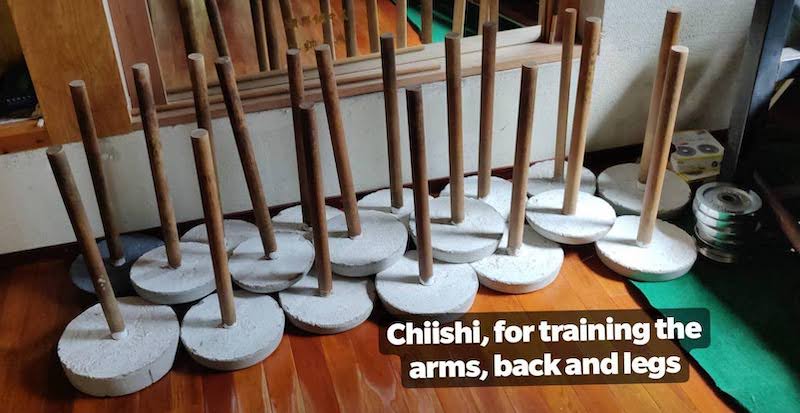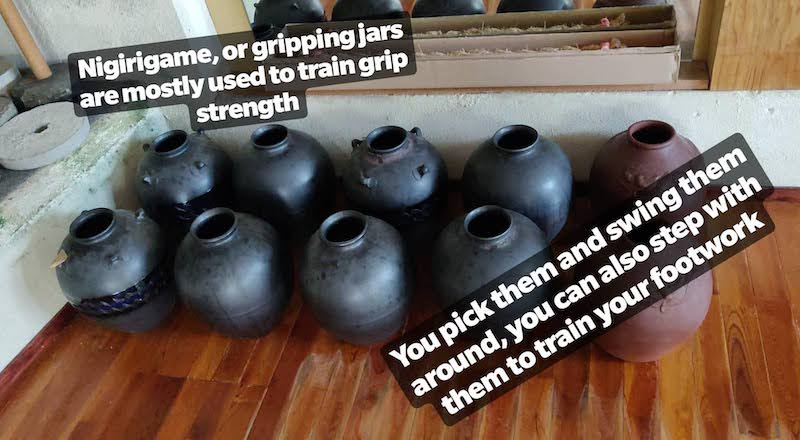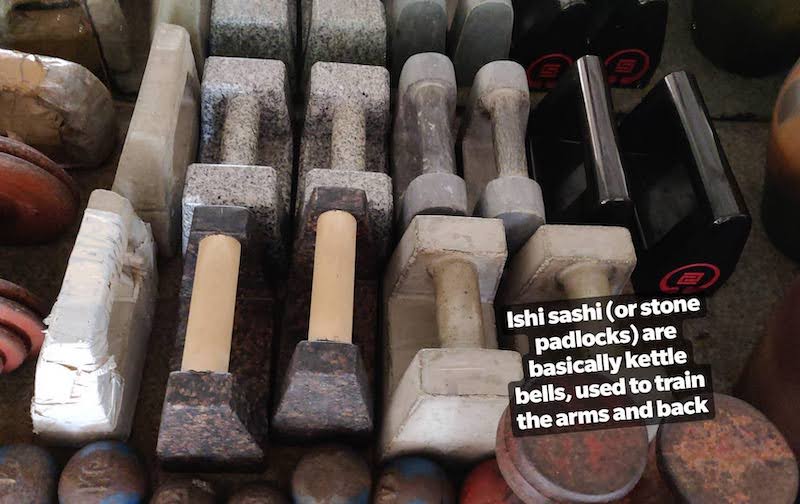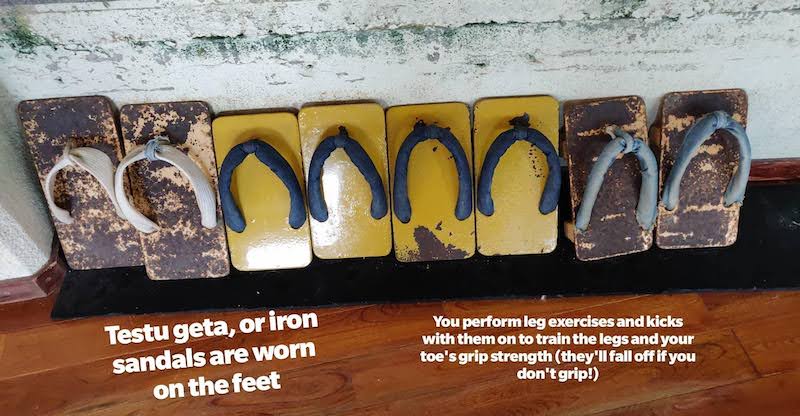Hojo Undo () means "Supplementary Exercise(s)" and generally refers to the use of tools to assist one's training.
Lifting Tools
Chiishi

Short for "Chikara Ishi" or "Strength Stone", the Chiishi was traditionally a stone on the end of a wooden stick, the weight of them varies quite a lot but 3kg would seem to be common (although not particularly heavy compared to some others, with chiishi well over 5kg). That said they can be made from whatever you like and you can find varieties that are made with concrete, weights like you'd find on an adjustable barbell, and pieces of metal (such as old large gears).
Chiishi are used to increase the strength of one's grip, fingers, wrists, arms, shoulders and back, as well as the dropping of body weight development of breathing rhythms and improved shikodachi from squatting while using the chiishi. There are several exercises for the chiishi, and while they are simple they are quite effective if performed regularly. The Chiishi appears to have originated from one (or both) of two tools used in Okinawa, grinding stones used for the preparation of food and looms used for spinning textiles. Both these tools have more than a passing resemblance to chiishi and were commonplace.
Makiage
Another basic tool, the Makiage 「」 (roller/hoister) commonly referred to in English as a "Wrist Roller", is a simple tool composed of a stick, with a rope attached to the middle of it, with some kind of weight attached to the rope. You hold the stick horizontal, and "roll it" up/down which winds/unwinds the rope around the stick and lifts/lowers the weight. This tool does wonders for one's grip strength and forearms, and it will quickly leave users with burning forearms if they're unused to utilising their grip so much.
The Makiage is sometimes referred to as a "Makiage kigu" 「」, which means "rolling/hoisting tool". "Maki" 「」 comes from the word "maku" 「」, which means to wind/roll/coil, and "age" 「」 comes from the word "ageru" 「」 which means "to raise". "Kigu" 「器具」 means "tool".
Nigiri Game

Nigiri Game (握甕 - ニギリガメ)translates roughly as "gripping jars", they are also sometimes referred to as "Sanchin Jars". These are used to train grip strength as well as arm and back strength. These are simply jars which are gripped on the lip of the jar. The jars may simply be held while the user steps (Sanchin stepping, or Shikodachi stepping) or they may be raised and lowered as well.
The weight and size of the jars differs but, if a jar is too light or becomes to easy to use, it is common to fill it with things like water/sand/rocks to increase it's weight.
Ishi Sashi

Ishi Sashi or Saashii (石錠 or サーシー), are literally translated as Stone Padlocks.
Kongoken
A creation of Chojun Miyagi, the Kongoken (金剛圏 - コンゴウケン) is based off of large, man sized iron circles he saw being used by Hawaiian wrestlers to train when he visited Hawaii in the mid 1930s. He was apparently so impressed with the tool he brought one or more home when he returned to Okinawa around 1935. Miyagi modified the design to make it closer to the human body, flatting the sides so it now resembles more of a rectangle with circular ends. A Kongoken is normally around 150-165cm tall and around 20-25kg heavy, it can be used as a weight for regular strength exercises or it can be lifted, rotated and manipulated in various ways to simulate and train methods and techniques for things such as throwing, controlling and otherwise moving an opponents body.
Tetsu Geta

Literally "Iron Sandals" the Tetsu Geta () are sandals made of iron, true to the name. They are used to train the gripping power of the toes (you've got to squeeze hard to keep the heavy sandals on your feet) and the muscles of the legs by performing leg raises or leg swings. Other varieties include regular wooden sandals with bits of metal attached to the bottom of them and the original tool, the "Stone Sandals", "Ishi Geta" (). These are carved from stones and may use things like rope or even fencing wire for the sandal's "string".
Impact Tools
Makiwara
The Makiwara()is a post for striking, buried in the ground with (traditionally) straw rope wrapped around it near the top, however several variations of the design exist. The Makiwara is used to train one's striking power and technique, it can be punched, kicked and struck in pretty much whatever what you feel like as long as the design allows for it.
The original makiwara was a round post with rope around it, which while can be struck, has little give to it (if any) and the round surface could make some techniques (i.e. a straight punch) difficult to perform. The straw is said to have also discoloured the knuckles of those who used it, and if straw splinters got into a cut or abrasion on one's knuckles it was quite painful.
Nowadays the posts tend to be a plank of wood that flexes when hit (achieved by using a plank that is thinner at the top than at the bottom) with a leather pad attached to top, this pad may be removable and the post could be buried or bolted to the floor. This design allows for much more give in the post which is means it's safer to strike with intensity with less risk to ones joints.
Other variations include:
- Circular posts with one or more slits cut into them down the middle in order to let them give on a strike
- Portable Makiwara held by two people and struck by a third (imagine a long horizontal plank with two people holding either side)
- Makiwara with a pad near the bottom for kicking
- Wall attached Makiwara, usually composed of a block of wood with one or more slits cut one after the other in middle of the wood to allow for give
- Wooden plank Makiwara with slits cut into them
To be added: (picture of a traditional rope post) (picture of a modern rope post) (picture of a modern leather post) (picture of the giant makiwara)
Tou
The Tou (とう) is a bundle of dried bamboo tied together. This bundle is used to train one's striking abilities or to condition one's extremities. It can be struck with the arms, kicked, gripped or even stabbed with a thrust of one's fingers. A Tou may be vertical or horizontal, different configurations lend themselves better to different training techniques. Very useful for training nukite, but not recommenced until you have conditioned your hands somewhat.
Jari Bako
Literally "Gravel/Pebble Box", the Jari Bako ()is exactly what it sounds like, a box of small rocks. This can be used for a variety of exercises such as stabbing into the stones with ones fingers, or reaching in and gripping the stones. Also known as "Suna bako" () which means "Sand Box" or "Kan shu" (カンシュ), I believe the latter is an Okinawan word, I'm unsure as to it's exact meaning.
As the alternate names imply, these boxes can hold more than just rocks and in fact, starting with something less rough like rice is recommended until your hands are tough enough to endure more unforgiving materials.
Ishi
Ishi literally means rock or stone. They can be used for weight training or conditioning exercises. Morio Higaonna Sensei is famous for his use of the Ishi to condition his hands.
